Related Research Articles
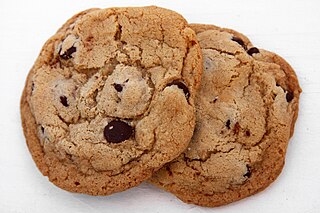
A cookie, or a biscuit, is a baked or cooked snack or dessert that is typically small, flat and sweet. It usually contains flour, sugar, egg, and some type of oil, fat, or butter. It may include other ingredients such as raisins, oats, chocolate chips, nuts, etc.
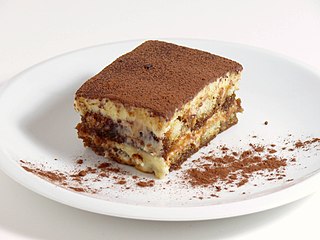
Tiramisu is a coffee-flavoured Italian dessert. It is made of ladyfingers (savoiardi) dipped in coffee, layered with a whipped mixture of eggs, sugar, and mascarpone cheese, flavoured with cocoa. The recipe has been adapted into many varieties of cakes and other desserts. Its origins are often disputed among Italian regions Veneto and Friuli Venezia Giulia.

Trifle is a layered dessert of English origin. The usual ingredients are a thin layer of sponge fingers or sponge cake soaked in sherry or another fortified wine, a fruit element, custard and whipped cream layered in that order in a glass dish. The contents of a trifle are highly variable and many varieties exist, some forgoing fruit entirely and instead using other ingredients, such as chocolate, coffee or vanilla. The fruit and sponge layers may be suspended in fruit-flavoured jelly, and these ingredients are usually arranged to produce three or four layers. The assembled dessert can be topped with whipped cream or, more traditionally, syllabub.

A biscuit is a flour-based baked and shaped food product. In most countries biscuits are typically hard, flat, and unleavened. They are usually sweet and may be made with sugar, chocolate, icing, jam, ginger, or cinnamon. They can also be savoury, similar to crackers. Types of biscuit include sandwich biscuits, digestive biscuits, ginger biscuits, shortbread biscuits, chocolate chip cookies, chocolate-coated marshmallow treats, Anzac biscuits, biscotti, and speculaas.

A bakery is an establishment that produces and sells flour-based food baked in an oven such as bread, cookies, cakes, donuts, pastries, and pies. Some retail bakeries are also categorized as cafés, serving coffee and tea to customers who wish to consume the baked goods on the premises. Confectionery items are also made in most bakeries throughout the world.

Mary and Eliza Chulkhurst, commonly known as the Biddenden Maids (1100–1134), were a pair of conjoined twins supposedly born in Biddenden, Kent, England, in the year 1100. They are said to have been joined at both the shoulder and the hip, and to have lived for 34 years. It is claimed that on their death they bequeathed five plots of land to the village, known as the Bread and Cheese Lands. The income from these lands was used to pay for an annual dole of food and drink to the poor every Easter. Since at least 1775, the dole has included Biddenden cakes, hard biscuits imprinted with an image of two conjoined women.

Shortbread or shortie is a traditional unleavened Scottish biscuit usually made from one part white sugar, two parts butter, and three to four parts plain wheat flour. Unlike many other biscuits and baked goods, shortbread does not contain any leavening, such as baking powder or baking soda. Shortbread is widely associated with Christmas and Hogmanay festivities in Scotland, and some Scottish brands are exported around the world.
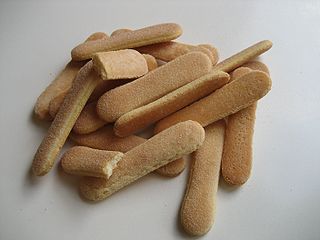
Ladyfingers, or in British English sponge fingers, are low-density, dry, egg-based, sweet sponge cake biscuits roughly shaped like large fingers. They are a principal ingredient in many dessert recipes, such as trifles and charlottes, and are also used as fruit or chocolate gateau linings, and for the sponge element of tiramisu. They are typically soaked in a sugar syrup or liqueur, or in coffee or espresso for tiramisu. Plain ladyfingers are commonly given to infants, being soft enough for teething mouths, but easy to grasp and firm enough not to fall apart.
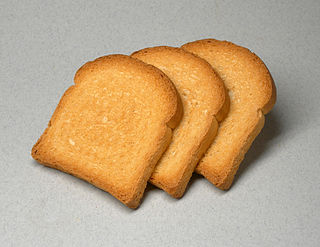
A rusk is a hard, dry biscuit or a twice-baked bread. It is sometimes used as a teether for babies. In some cultures, rusk is made of cake, rather than bread: this is sometimes referred to as cake rusk. In the UK, the name also refers to a wheat-based food additive.
Nice Cup of Tea and a Sit Down is a website which mainly discusses tea and biscuits, with content including news and reviews of biscuit brands. It is owned and maintained by Stuart Payne and his wife Jenny Payne, who live in Cambridge, England, and spawned a spin-off book of the same name.

McVitie's is a British snack food brand owned by United Biscuits. The name derives from the original Scottish biscuit maker, McVitie & Price, Ltd., established in 1830 on Rose Street in Edinburgh, Scotland. The company moved to various sites in the city before completing the St Andrews Biscuit Works factory on Robertson Avenue in the Gorgie district in 1888. The company also established one in Glasgow and two large manufacturing plants south of the border, in Heaton Chapel, Stockport, and Park Royal, London. There are seven McVitie's factories in the UK, with each producing a different types of biscuit; the Harlesden site in north-west London manufactures the chocolate digestives.

A tea party is a social gathering event held in the afternoon. For centuries, many societies have cherished drinking tea with a company at noon. Tea parties are considered for formal business meetings, social celebrations or just as an afternoon refreshment.

Rich tea is a type of sweet biscuit; the ingredients generally include wheat flour, sugar, vegetable oil and malt extract. Originally called Tea Biscuits, they were developed in the 19th century in Yorkshire, England for the upper classes as a light snack between full-course meals. One of the best-selling biscuits in the British Isles, the biscuit is also popular in Malta and Cyprus. The plain flavour and consistency of rich tea makes them particularly suitable for dunking in tea and coffee. It is also common to apply spreads such as butter and/or preserves to the back of rich tea biscuits.
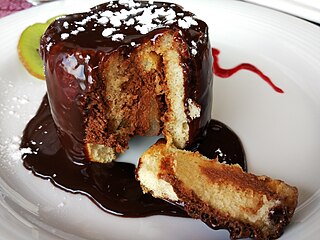
A charlotte is a type of bread pudding that can be served hot or cold. It is also referred to as an "icebox cake". Bread, sponge cake, crumbs or biscuits/cookies are used to line a mold, which is then filled with a fruit puree or custard. The baked pudding could then be sprinkled with powdered sugar and glazed with a salamander, a red-hot iron plate attached to a long handle, though modern recipes would likely use more practical tools to achieve a similar effect.

Zuppa Inglese is an Italian dessert layering custard and sponge cake, perhaps derived from trifle.

A Sally Lunn is a large bun or teacake, a type of batter bread, made with a yeast dough including cream and eggs, similar to the sweet brioche breads of France. Sometimes served warm and sliced, with butter, it was first recorded in 1780 in the spa town of Bath in southwest England. As a tea cake it is popular in Canada, England and New Zealand.

Tea has long been used as an umbrella term for several different meals. English writer Isabella Beeton, whose books on home economics were widely read in the 19th century, describes meals of various kinds and provides menus for the "old-fashioned tea", the "at-home tea", the "family tea", and the "high tea".

An oatcake is a type of flatbread similar to a cracker or biscuit, or in some versions takes the form of a pancake. They are prepared with oatmeal as the primary ingredient, and sometimes include plain or wholemeal flour as well. Oatcakes are cooked on a griddle or baked in an oven.
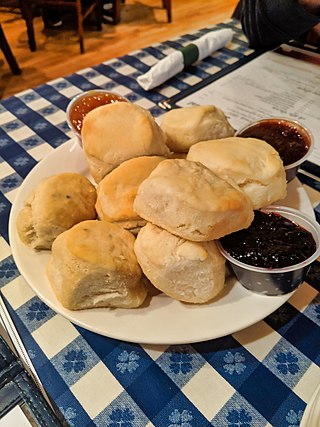
In the United States and Canada, a biscuit is a variety of baked bread with a firm, dry exterior and a soft, crumbly interior. It is made with baking powder as a leavening agent rather than yeast, and at times is called a baking powder biscuit to differentiate it from other types. Like other forms of bread, a biscuit is often served with butter or other condiments, flavored with other ingredients, or combined with other types of food to make sandwiches or other dishes.

Sponge cake is a light cake made with egg whites, flour and sugar, sometimes leavened with baking powder. Some sponge cakes do not contain egg yolks, like angel food cake, but most of them do. Sponge cakes, leavened with beaten eggs, originated during the Renaissance, possibly in Spain. The sponge cake is thought to be one of the first of the non-yeasted cakes, and the earliest attested sponge cake recipe in English is found in a book by the English poet Gervase Markham, The English Huswife, Containing the Inward and Outward Virtues Which Ought to Be in a Complete Woman (1615). Still, the cake was much more like a cracker: thin and crispy. Sponge cakes became the cake recognized today when bakers started using beaten eggs as a rising agent in the mid-18th century. The Victorian creation of baking powder by English food manufacturer Alfred Bird in 1843 allowed the addition of butter to the traditional sponge recipe, resulting in the creation of the Victoria sponge. Cakes are available in millions of flavours and have many recipes as well. Sponge cakes have become snack cakes via the Twinkie.
References
- 1 2 "Queer Welsh Customs." Hampshire/Portsmouth Telegraph, 4 Aug. 1900. British Library Newspapers. Accessed 12 Nov. 2021.
- ↑ "SCOTCH FUNERALS." Manchester Times, 22 July 1882. British Library Newspapers. Accessed 13 Nov. 2021.
- 1 2 Gentleman's Magazine and Historical Review. 1790. pp. 118–.
- ↑ "The Provinces." Northern Star [1838], 29 Sept. 1849. British Library Newspapers. Accessed 13 Nov. 2021.
- ↑ Coles, Terri (22 July 2018). "Digging into St. John's history with the Tea and Tombstones tour". CBC News. Retrieved 27 September 2021.
- ↑ Jacqueline S. Thursby (1 January 2006). Funeral Festivals in America: Rituals for the Living. University Press of Kentucky. pp. 84–. ISBN 978-0-8131-7183-8.
- ↑ Callaghan, Brenda Doreen (2000). Death, Burial and Mutuality (PDF). Victoria, Canada: University of Victoria. p. 57.
- ↑ "CHRISTIAN HAZELL'S MARRIED LIFE." Englishwoman's Domestic Magazine, vol. 22, no. 149/147, 1 Mar. 1877, pp. [113]+. Nineteenth Century UK Periodicals. Accessed 12 Nov. 2021.
- ↑ New York Times. "Maids and Matrons." Milwaukee Journal, 13 Jan. 1897, p. 5. Nineteenth Century U.S. Newspapers. Accessed 12 Nov. 2021.
- ↑ "Our Picayunes." Daily Picayune, 8 Dec. 1893, p. 4. Nineteenth Century U.S. Newspapers. Accessed 12 Nov. 2021.